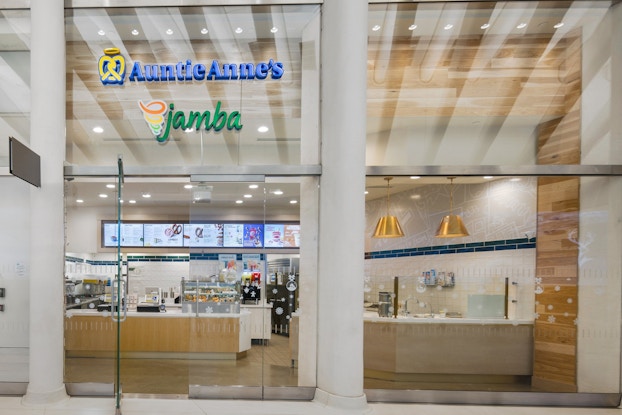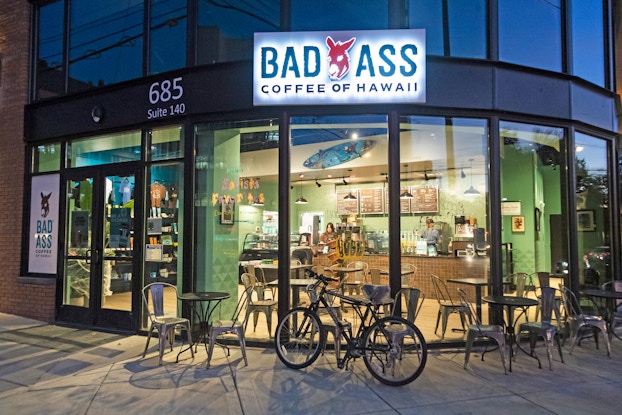Why it matters:
- The restaurant industry is still working to recover from the impacts of the pandemic in an ongoing challenging environment marked by a labor crunch and ongoing inflation.
- Driving sales and traffic while improving operational efficiencies via strategies ranging from co-branded restaurant locations to creating ambiance with music and store design are key to success, according to quick-service restaurant executives.
- Technology, from voice-to-text ordering to artificial intelligence that more accurately predicts the time a customer will receive a food delivery, is helping operators achieve their growth goals, both in terms of customer interactions and behind the scenes.
The restaurant industry is rebounding from the massive impact of the pandemic, although many operators continue to struggle amid an ongoing labor crunch, persistent inflation, and other pressures.
Some quick-service restaurant (QSR) companies, including Focus Brands, Marco’s Pizza, and Bad Ass Coffee of Hawaii, are focusing in on innovative strategies to attract customers and grow their businesses in the challenging foodservice environment that is expected in the year ahead. These include co-locating two restaurant concepts with each other to drive sales and efficiencies at Focus Brands, incorporating technology that streamlines operations and improves the customer experience at Marco’s, and enhancing the in-store ambiance to attract in-store traffic at Bad Ass Coffee of Hawaii.
A recent report from research firm the NPD Group noted that the restaurant industry continues to recover from its 2020 decline, with restaurant visits up 3% in January, compared with a year ago. Foodservice consumer spending rose 7% in the month, compared to a year ago.
Takeout and delivery sales soared for many operators during the pandemic, and the report found that these channels have remained robust, while at the same time dine-in sales have also increased. In January, dine-in visits at restaurants were up 24%, lapping a gain of 41% in January 2022.
“Although the pandemic is still informing the foodservice industry narrative, there are areas of meaningful growth and recovery,” said David Portalatin, Food Industry Advisor at NPD. “Consumers still need and want foodservice experiences and convenience, and we see the light at the end of this long tunnel [peeking] through.”

Focus Brands grows with co-branded restaurant locations
Focus Brands, the parent of restaurant chains Auntie Anne’s, Carvel, Cinnabon, Jamba, McAlister’s Deli, Moe’s Southwest Grill, and Schlotzsky’s Deli, is doubling down on a strategy to drive traffic by combining two of those concepts in a single location — a strategy known as dual branding.
“We believe this is going to be a huge year for dual branding at Focus Brands,” said Brian Krause, Chief Development Officer at Focus Brands.
Most of the dual-brand locations the company plans to open in 2023 are co-locations of the company’s Auntie Anne’s pretzel concept and its Jamba smoothie and juice brand.
Focus Brands is also planning its first Cinnabon Swirl locations — a new concept that’s a blend of the Cinnabon and Carvel brands, offering both the baked cinnamon roll treats that Cinnabon is known for as well as ice cream from Carvel. Test locations began opening in March.
As Focus Brands’ dual-branding efforts have gained momentum, the company has seen positive results at many of its franchisee’s locations in terms of average unit volume and unit-level economics, said Krause. In 2022, more than 60 of the U.S. locations that Focus opened were co-branded or co-located with another brand in the company’s portfolio.
“As more dual brands open, we continue to analyze [profitability] and buildout costs to understand economics and gain valuable insights for us to optimize formats and maximize efficiencies,” said Krause.
Focus Brands is uniquely positioned for success in the co-branding space, he said, thanks to its four iconic specialty brands that all operate within the same portfolio. Each of its concepts — from Carvel to Cinnabon — is run as a unique brand withing the company, while also leveraging a corporate structure that Krause said allows the company to manage across brands efficiently and effectively.
“More than ever, we are harmonizing the way that we manage and develop our brands,” he said.
Takeout and delivery sales soared for many operators during the pandemic, and the report found that these channels have remained robust, while at the same time dine-in sales have also increased.Data from the NPD Group
In order to be successful, dual-brand locations need seamless integration of their technology, such as the point-of-sale (POS) systems, as well as well thought-out integration of the physical space and the overall guest experience.
“We’ve made great strides in these areas to ensure a seamless experience for franchisees, employees and, guests, and will continue to do so quickly and nimbly,” said Krause.
The kitchen area also needs to be designed to ensure maximum efficiency and overall speed of service, he said. Focus Brands evaluated its equipment and other needs, and, with franchisee input, improved its back-of-house layouts. For locations that have drive-thru windows, the company also developed order-staging areas to provide faster service and improve order accuracy.
The company also is investing heavily in technology, upgrading its loyalty programs and digital ordering channels to help drive business and increase sales for franchisees, Krause said.
[Read: 4 Smart Strategies That Are Driving Sales in a Slow-Growth Year]

Technology enhances customer experience, operations at Marco’s
Technology is also key to the growth plans at Marco’s Pizza, Rick Stanbridge, Executive Vice President and Chief Information Officer, told CO—.
The company, which has more 1,100 locations, also has more than 200 additional stores in various stages of development. Last year, it opened more than 90 locations and 140 franchises.
To help ensure that these locations are optimized to drive operational efficiencies and enhance the customer experience, Marco’s has committed to investing millions of dollars in technology innovations during the next few years, Stanbridge said, with once such project being migrating to a 100% cloud-based technology platform. Dubbed Marco’s Order Management System (MOMS), the platform includes voice-to-text ordering and also utilizes artificial intelligence (AI) and machine learning to generate automated delivery times on orders that customers place with third-party delivery players.
“MOMS will be a key area of focus in 2023,” he said.
The fully integrated enterprise technology platform supports payment processing, including features such as conversational ordering, labor scheduling, and inventory management functions.
“This platform is set to be a revolutionary step for our brand as it is designed to improve the customer experience as well as simplify operations for franchisees and store team members,” said Stanbridge.
Using AI and machine learning to generate delivery times — what the company calls “Automated Promise” times — has been a particular area of focus. These technologies take into consideration variables including store product capacity, staffing, oven time, number of drivers, weather, and traffic conditions.
As a result of implementing this program, customer satisfaction has increased, Stanbridge said, because the technology is able to predict the time to deliver an order within plus or minus five minutes.
Marco’s has also been leaning heavily into enhancing its app and online ordering functions. The company has expanded the availability of digital ordering across its markets, and reduced the time it takes to place an online order by two-thirds in the last four years, Stanbridge said.
Marco’s is prioritizing technologies that create a better customer experience, with a focus on improving store-level profitability, he said.
Marco’s also remains prepared as new technologies emerge, Stanbridge said. For example, by housing its data with MOMS, Marco’s can respond to new ordering platforms such as Alexa, Siri, and Google, remote-kiosk ordering, GPS-pinpointed delivery, and instant ordering via social media.

Bad Ass Coffee of Hawaii focuses on the in-store experience
For Bad Ass Coffee of Hawaii — named after the donkeys that once carried coffee beans on the steep slopes of Kona on the Big Island — creating an in-store experience where people can gather and chill is a key element of the company’s growth strategy, said Scott Snyder, CEO.
“People have an innate need to gather, to interact, to be with one another, to converse, to have live human contact,” he told CO—. “We think that's important. And when you have an experiential brand like Bad Ass Coffee of Hawaii where the in-store experience is different than your normal coffee shop — it's very warm, it's very colorful, the music is every bit of a hint of Hawaii as well as surfing and an easy lifestyle, easy vibe.”
While many restaurants are creating takeout-only prototypes and downsizing their dining rooms to focus on takeout and delivery, Bad Ass Coffee of Hawaii is doubling down on ensuring that people have a place they can sit and relax, if they choose to do so.
Most of the locations the brand is opening accommodate both types of consumer demands, with a drive-thru for people on the go, and a comfortable seating area for people who want to chill. The company’s ideal strategy is to build its first location with a full seating area and a drive-thru, so that consumers in the market become familiar with its Hawaiian vibe.
Snyder’s company, Royal Aloha Coffee LLC, acquired the brand in July 2019, when it was already nearly 30 years old. It had been founded in Hawaii, and sought to project a Hawaiian ambiance, but Snyder and his team rethought the décor and created what he said was a more authentic Hawaiian experience in the store, with a “less touristy” vibe. The company’s strategies appear to be working, he said, noting that average store sales increased more than 76% from 2019 through 2021.
While most coffee shops are either dark and industrial, or else very bright and “almost sterile, like a surgical suite,” he said, Bad Ass Coffee of Hawaii features a warm color scheme, with photos of Hawaiian scenery such as coffee farms and flowers, and beachy music playing.
“It's a full sensory experience when you walk into a Bad Ass Coffee of Hawaii,” said Snyder. “I think that creates an environment where people want to linger — a place where people are going to want to stay and talk with one another and communicate. And of course we hope that the longer that you're there, the more friends you bring, and that you're going to have to refill that cup of coffee at some point.”
The brand has about 30 stores open, and another dozen stores that are under construction. Franchisees have acquired the rights to build another 70 or so stores.
The prototypical store is about 1,650 square feet, with seating for about 13 to 18 customers. Most of the new stores being built now have both a drive-thru window and a sit-down café.
Individual franchisees sometimes deploy other strategies to drive traffic into the stores, such as tasting sessions or live music.
Snyder said he believes the launch of a mobile app last year that allows customers to order ahead is also helping drive in-store traffic, as many customers seem to appreciate the ability to order ahead and then have the option of consuming it on- or off-premises.
CO— aims to bring you inspiration from leading respected experts. However, before making any business decision, you should consult a professional who can advise you based on your individual situation.
CO—is committed to helping you start, run and grow your small business. Learn more about the benefits of small business membership in the U.S. Chamber of Commerce, here.









